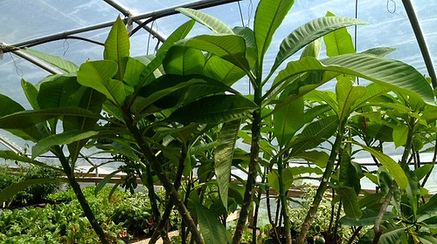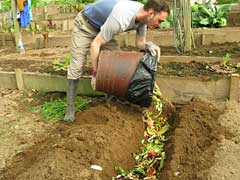
tel: 512 280-1192 Friday, Sept 20 2013
Important: Sunday's lecture by Walter Stewart on re-wilding land-
scapes has been cancelled. Walter sends his profound apologies.
Look for a new date for him in November.
______________________________________________________
Nursery Notes: The time for fall gardening has arrived... along
with some wonderful overnight rain. Choose from a wide array of
veggies that we have at the nursery to stock your garden: cabbage,
cauliflower, Brussels sprouts, broccoli; 5 varieties of kale; lettuce
- buttercrunch, red leaf and gourmet bib; spinach; bright lights
swiss chard; dill and lots of fall herbs; winter flowers just in -
pansies, snapdragons; fall grasses - big muhly, coastal muhly,
bamboo muhly, maiden grass, dixieland maiden grass (new varie-
gated form); 5 gal passionflower vines, 6' tall, for $34.99 (host for
the gulf frittilary butterfly).

Two gallon plumerias, 4' tall, reg. price $24.99; on sale for $9.99.
_______________________________________________________
Wildflower Center Free this Sunday as part of Austin Museum Day.
Opening hours: 9 a.m. - 5 p.m. Special events all day, including an
11 a.m. lecture on plant aphrodisiacs by Dr. Molly Ogorzaly. More
details here: http://www.wildflower.org/austinmuseumday/
________________________________________________________
Success with Berries and Fruit.... and How to Make Jam - free
lecture next Sunday (2 p.m. Sept. 29). Learn from Amanda Moon
how to get the most out of your fruit and berry crops.
________________________________________________________
Another rave review of the nursery on Yelp. "I've been coming to It's
About Thyme for several years now," writes SS from Buda. "Chris and
his staff have turned me into a gardener. They're great about coaching
and helping me avoid pitfalls. Always willing to stop, listen, teach and
explain. The service is excellent.... This is a hidden South Austin gem!
Write your review at: http://www.yelp.com/biz/its-about-thyme-austin
________________________________________________________
Central Texas Gardener KLRU TV. Meet unique Texas butterflies
and ones that wing it across the country, with guests from the National
Butterfly Center in Mission. On tour, small-space gardener Ida Bujan
attracts wildlife all year. Sat. noon, 4 p.m. or Sun. at 9 a.m. www.klru

Fill in your trench with whatever material you have available.
The Art of Trench Composting
By Tim Miller
Organic farmer Tim Miller of Millberg Farm in Kyle recently visited
our nursery to explain about this innovative new method of composting.
Here are some of Tim’s notes. – Chris Winslow)
As we struggle through yet another year of drought, it seems that this
should be a time for us all to modify and tweak our gardening tech-
niques to meet this challenge. In this context one method I have found
that works very effectively on my farm is called trench composting.
It has a fairly simple set-up, takes most of the work out of composting,
and could help to create bountiful crops in all of the organic vegetable
patches in the Hays and Travis counties.
Basically the only tool that you need is a shovel. The hardest part is the
digging of the trench, which can range from 3 feet to 6 inches deep.
Obviously the deeper you dig down depends on the depth of your soil
and your physical energy.
Dig down what you can remove with ease. Then soak the trench and
come back two days later and proceed to remove the soil to the depth
that you want. The trench only needs to be one shovel blade wide for
community garden sites.
After digging and throwing the soil onto the adjacent bed you can now
start filling in your trench with whatever material you have available.
Putting corn and okra stalks on the bottom, then a foot layer of grass
clippings will ensure the stalks of heating up.
Additional materials could be leaves, hay, woodchips and other garden
debris. Fill the trench up to the top of the bed before you start digging
your bed. If you start digging the bed before the trench is filled the
sided will collapse.
After filling it in, only walk on the pathway (trench) and in 6 months
the materials will have decomposed. A simple shoveling of the compost
onto the planting bed, then filling in the trench before incorporating the
compost into your bed is all it takes.
This method is a time-saver if used correctly. Even with a cold front
passing by, you can loosen up the trench with a tiller or digging fork,
then cover your whole garden with row cover and you’ll save your crops
from freezing. The heat will permeate up from the trench but will be
trapped by the row cover.
The Benefits of Trench Composting
1 Time saved because you will not have to turn material.
2. With the addition of organic material directly into the ground the
root systems of squashes, tomatoes, basil, okra will alter their growth
towards and under the trench.
3. Watering your trench will leach out nutrients for the established
plants.
4. You will not get muddy feet when walking on the trench pathway
that was filled with leaves.
5. Heat generated from decomposition will warm your garden during
cold periods.
6. This is a method of stockpiling lots of leaves.
7. For community gardeners who leave their garden, the next gardener
will have a supply of compost on hand.
8. Trenches are not unsightly like most compost bins and materials are
needed to build it other than a shovel.
9. Weeds will not grow in the trenches.
10. Compost is right next to the garden bed. No more hauling compost
around in wheelbarrows.
Happy gardening everyone!
 Visit the website: www.itsaboutthyme.com
Visit the website: www.itsaboutthyme.com Visit the nursery:11726 Manchaca Road, Austin, 78748 Facebook: